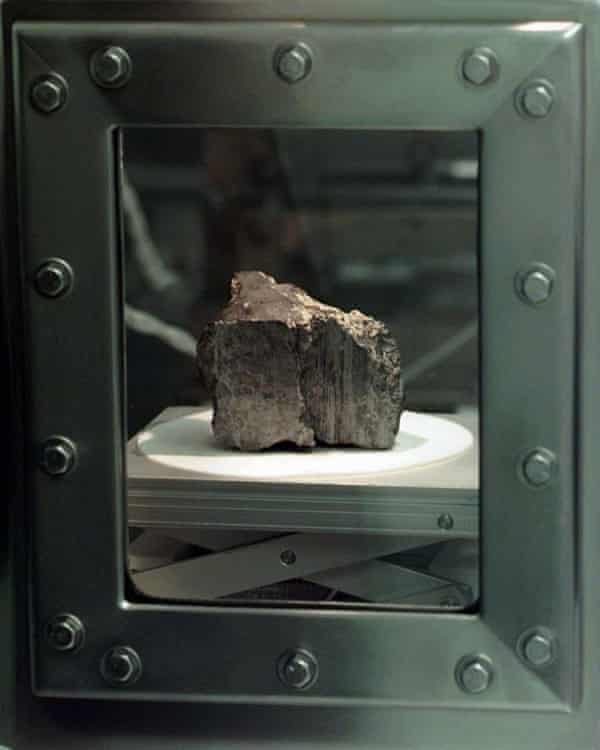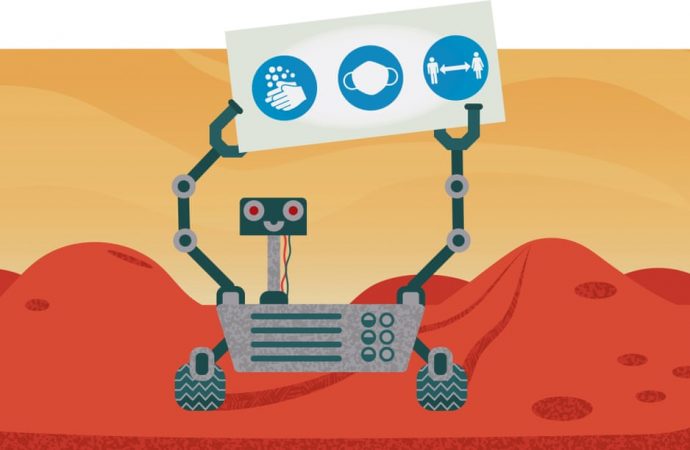As countries begin an age of Martian exploration, planetary protection advocates insist we must be careful of interplanetary contamination
Source: The Guardian
Next month, three new spacecraft arrive at Mars. Two represent firsts for their countries of origin, while the third opens a new era of Mars exploration. The first is the UAE’s Emirates Mars Mission, also known as Hope, which enters orbit on 9 February. Shortly after, China’s Tianwen-1 settles into the red planet’s gravitational grip and in April will deploy a lander carrying a rover to the surface.
Both of these missions are groundbreaking for their countries. If they are successful, their makers will join the US, Russia, Europe and India in having successfully sent spacecraft to Mars. However, it is the third mission that is destined to capture the most headlines.
On 18 February, around 8pm GMT, Nasa will attempt to land the car-size rover Perseverance in Jezero crater. It’s got a long list of science objectives to work through. “We want to get a fuller understanding of how Mars formed as a planet,” says Sanjeev Gupta of Imperial College London, who is part of the Perseverance science team.
On Earth, the constant shifting of the crust has mostly destroyed the very first surface rocks to form, but on Mars the oldest rocks are preserved, so there is an unbroken record stretching back more than four billion years. As well as telling us about the history of the planet’s formation, those primeval rocks could also contain clues as to whether life ever began on the red planet.
Yet what makes Perseverance unique is that it is also the first part of an ambitious 10-year plan between Nasa and the European Space Agency (Esa) to bring Martian rocks to Earth in around 2031.
“Scientists really want rocks from Mars back on Earth,” says Gupta. Samples can be analysed much more thoroughly on Earth than using even the most sophisticated Mars rover. And because laboratory techniques improve constantly, they can continue to be inspected year after year for new discoveries.
If you discover signs of life on Mars, you want to know that’s Martian life
The value of sample return was demonstrated in the 1970s when the analysis of moon rocks brought back by the Apollo astronauts changed our understanding of the solar system’s history and formation.
To replicate this success for Mars, Perseverance is equipped with more than 30 canisters, into which interesting-looking rocks will be loaded and then cached on the surface. If all goes well, a European rover built at Airbus Defence and Space in Stevenage will arrive on Mars in 2028 to collect the canisters. It will load them into a Nasa spacecraft known as the Mars Ascent Vehicle, which will blast them to a rendezvous with the European supplied Earth Return Orbiter that will bring the samples to Earth.
Whereas the lunar samples of the 1970s were from a barren world, Mars could once have been a habitable planet. So key investigations will involve looking for evidence of past – or possibly present – life and that is a whole new ballgame.
“If you discover signs of life on Mars, you want to know that’s Martian life, right? You don’t want to accidentally discover E coli bacteria that hung on to your spacecraft,” says Casey Dreier, chief advocate and senior space policy adviser for the Planetary Society, a non-profit organisation for space advocacy based in Pasadena, California.
To keep the scientific results as pure as possible, spacecraft and equipment are cleaned with chemical solvents or by heating.
“When building a mission to Mars, you have to apply these biological controls that go beyond what we typically use for satellites that we build for, say, Earth observation,” says Gerhard Kminek, a planetary protection officer for Esa. He’s been working since 2004 to make sure such precautions become standard practice at Esa for anything going to Mars – including the Rosalind Franklin rover that will launch in 2022 and which carries life-detection equipment.

From working on Rosalind Franklin, European aerospace companies Airbus and Thales Alenia Space now have biologically controlled cleanrooms in which to build almost completely sterile spacecraft. “We’re in a very good position,” says Kminek, so much so that Nasa sent a delegation late last year to visit the facilities and learn from them.
Kminek is also spearheading studies into the kind of containment facility needed to hold Mars samples on Earth. Working with organisations such as Public Health England, the Porton Down laboratory and the European Centre for Disease Prevention and Controls, Thales UK and the University of Leicester have already built a prototype “double wall isolation chamber” under an Esa contract.
Such precautions are known as planetary protection, which is split into two components. Forward contamination is the introduction of Earth life on to other worlds; backwards contamination is concerned with the possibility, however remote, of extraterrestrial life brought back to Earth escaping into the biosphere.
It was initially discussed in the 1950s in the run-up to the launch of the first satellite, the Soviet Union’s Sputnik 1, and the Committee on Space Research (Cospar) issued its first planetary protection guidelines in 1959. Back then, scientists thought the solar system was much more habitable. “You read Arthur C Clarke novels written in the 50s that talk about native Martians and people don’t see that as being an absurdity,” says Thomas Cheney, lecturer in space governance at the Open University.
That all changed in 1971, when Mariner 9 became the first spacecraft to enter orbit around Mars. The pictures it sent back were sobering. There was no vegetation and no visible signs of life. Indeed, there was not even an indication of past life. “People were surprised at just how dead Mars actually turned out to look,” says Cheney.
Closer investigation in more recent decades, however, has swung opinions back again. It is now thought that Mars could have been habitable and that microbes may still be clinging on in areas of the planet where liquid water is present. Planetary protection concerns mean that spacecraft cannot go to these areas. So, life-detection experiments cannot investigate the areas most likely to support life and therefore most concentrate on looking for the evidence of past life on Mars.
Beyond these purely pragmatic scientific issues, however, a larger debate is brewing that brings in an ethical dimension. “It’s something that is, I think, even more important in a sense,” says Dreier. “It’s applying the lessons of horrendous mistakes that humans have made in terms of exploration in the past.”
Perhaps the most widely known of these mistakes is the European colonisation of Hawaii in the 18th century. Various diseases devastated the indigenous population because of the bacteria and viruses that were introduced. While there is no real chance of animal life on Mars, Dreier thinks the same consideration should be extended to bacteria. “If there’s life there, we don’t want to inadvertently introduce a competing form of life that could undermine or destroy that,” he says.
The Apollo missions would have been entirely impossible if someone had tried to enforce planetary protection
In truth, this concern has always underpinned the planetary protection guidelines, but its re-emergence as a discussion point is because Nasa and its partners are on the brink of returning humans to the moon. They also have ambitions for sending astronauts to Mars sometime in the 2030s and wherever humans go, contamination is sure to follow. We are – for want of a better word – leaky, even when enclosed in space suits. There is no such thing as a perfect seal, so viruses and bacteria will be constantly escaping into extraterrestrial environments.
The way we currently try to minimise the impact is to say that all areas with the potential for water are off limits, even to biologically decontaminated rovers such as Perseverance. Yet this will not work for human exploration, because water is going to be an essential resource for astronauts to drink and to make oxygen and rocket fuel with. Such “in-situ resource utilisation” is hard written into everyone’s plans for exploration.
On the face of it, planetary protection rules out a human exploration programme and all the scientific exploration that could bring. It would have scuppered the historic moon landings if anyone had thought about it too much. “The Apollo missions would have been entirely impossible if someone had tried to enforce planetary protection,” says Robert Zubrin, founder of the Mars Society, which advocates for human missions to Mars.
Those early astronauts left “several hundred pounds of metabolic waste” on the moon. This includes 96 bags of poo, urine, vomit and food waste. Apart from making the most historic feat of human exploration sound more like the aftermath of a student party, the point is that those waste products will have contained more than 1,000 microbial species usually found in the human gut.
Zubrin, whose book The Case for Mars is celebrating its 25th year in print, thinks that planetary protection is overcautious. He points to the subset of naturally occurring meteorites on Earth that have been shown to come from Mars and that this must have been happening since the formation of the solar system 4.6bn years ago.
One Martian meteorite in particular, ALH84001, aroused great interest in 1996 when a group of scientists claimed to have found microscopic fossils of Martian bacteria inside. Although that conclusion is still hotly contested, part of the analysis showed that the meteorite had never been subjected to temperatures above 40C. “If there had been microbes in it, they could have survived the trip,” says Zubrin, “and billions of tons of such material have transferred from Mars to Earth in the last four billion years.”‘
In other words, if nature does not respect planetary protection protocols, why should we?
Nasa recently commissioned a report on planetary protection. Published in October 2019, the Planetary Protection Independent Review Board recommended that different areas of a celestial body should be classified in different ways. Previously, the Cospar planetary protection rules applied to a celestial body as a whole. Now, specific areas can be protected while leaving others to be explored.
It’s a stopgap at best because the water-rich areas necessary for the establishment of permanent bases remain off limits. To make progress, Cheney would like to see planetary protection become part of a wider discussion about space as an environment, so that we can decide what our priorities are for space exploration.
“It’s not just a place where you can do anything you want. What you do has consequences,” he says. He points to space debris as something that could be rolled into a wider discussion of protecting the environment of space.
And there’s no time to lose. The Cospar planetary protection guidelines are not part of international law, so while its recommendations are written into the fabric of Nasa, Esa and other major space agencies, there is nothing to stop the burgeoning private space sector sending anything they want into space. And as the flotilla of missions arriving at Mars demonstrates, the red planet is no longer as remote as it once seemed.
Source: The Guardian

































Leave a Comment
You must be logged in to post a comment.